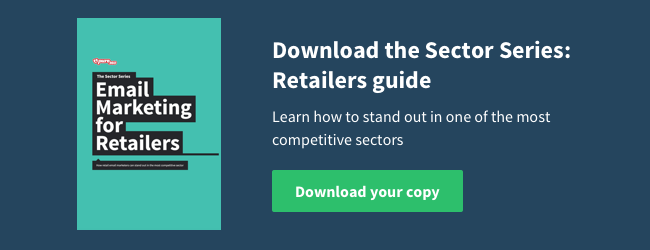If you want to know how to attract, guide and convert more visitors through your site then perfecting your email communications is essential.
For online retailers, email marketing is one of the most successful marketing tools they have available – driving an average of 23% of sales through this one channel alone (Econsultancy, 2014).
Of course there’s a whole range of emails you could send but it’s important you get the basics right first.
We’ll take you on a tour of the key emails you should be sending to convert browsing into purchases and turn visitors into loyal customers.
Welcome email
This is the email that subscribers receive when they sign-up to receive your emails. It should be used to welcome the potential customer to the brand, your services and most importantly prompt an initial purchase. Some retailers choose to incorporate a time-limited welcome offer to encourage this first transaction.
Browse and abandonment emails
If you’ve successfully captured your web visitors’ email addresses then you’ll be able to re-engage them when they leave with an abandonment email. Abandonment emails can be sent if someone has browsed without purchasing or placed an item in their cart without completing the transaction. Their sole purpose is to get the visitor to return.
Order confirmation
The relationship doesn’t end once your customer has purchased – it’s only just begun. Confirm, congratulate and reassure them with a prompt order confirmation summarising the details of their purchase and payment. This email should confirm what they bought, how they paid, your returns policy and customer service contact details.
Dispatch and delivery confirmation
For eCommerce customers great customer service means great delivery. Set expectations on delivery timescales, tell them whether or not they have a time slot for delivery and offer them a text service so they can be alerted on the day their delivery is due.
You may also like…
The best time to market to someone is when they’re already thinking about you. So there’s no better time to suggest the customer’s next purchase than when they’ve just bought something from you. Use the data they’ve given you from their last purchase and suggest something complementary to their last purchase to inspire their next one.
Back in-stock
Always give visitors the opportunity to request an automatic email when an item is back in-stock. These emails trigger a wave of traffic to your site as soon as you replenish your stock. It’s also a great customer service feature and discourages customers from finding alternatives.
Rate and review
Once the customer has received their order then ask them what they think. People like to be asked their opinion and it’s only good manners to show you care. Ratings and reviews are also cited as a major influence on people’s purchasing (MarketingLand.com, 2013). If the reply isn’t positive then always ask one of your customer service team to contact the customer.
Refer a friend
If the customer likes your service then go back to them and ask them to recommend you to a friend. Incentivise them if you need to, but personal referrals are a great way of acquiring new customers and shows prospective customers you’re doing a good job.
Replenishment
If the product you’ve sold has a certain shelf life then send a timely email to remind the customer to purchase again once. This works well for cosmetics, bath and body or electronic supplies. A friendly email asking whether they’d like to re-order a new product when you think their first purchase has come to an end can prompt another purchase.
Your next order
If you would expect to see the customer return within a certain amount of time and they haven’t then incentivise their next visit to your website. Send them an email with your latest product, news or products you think they’d like based on their last order. If they’re price sensitive it may be a good idea to offer them a discount on their next purchase.
We’ve missed you
If a customer hasn’t returned for a significant amount of time then re-engage them with a tempting offer to prompt a purchase. Remember it’s far more costly to acquire customers than it is to retain existing ones (Invespcro, 2013). Always have an automated campaign set-up to re-engage customers who may be lapsing.
When combined this series should take your casual visitors to loyal repeat customers.
Of course there are plenty of other opportunities to add and enhance but these emails should be the basic foundations for your customer journey.
Get these right and you’ll improve your conversion rate, reduce abandonment and increase your sales.

